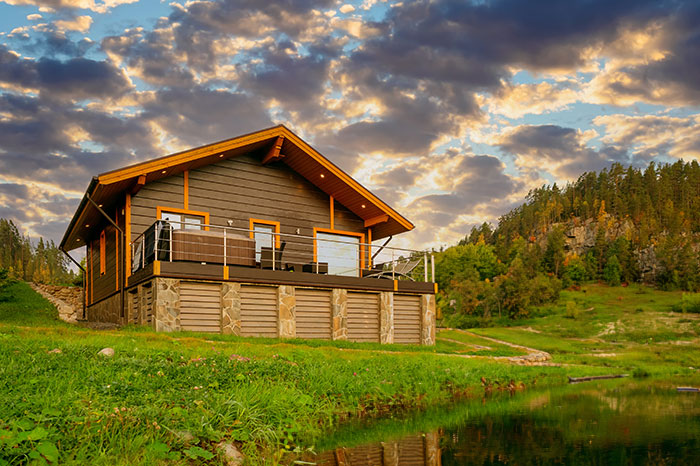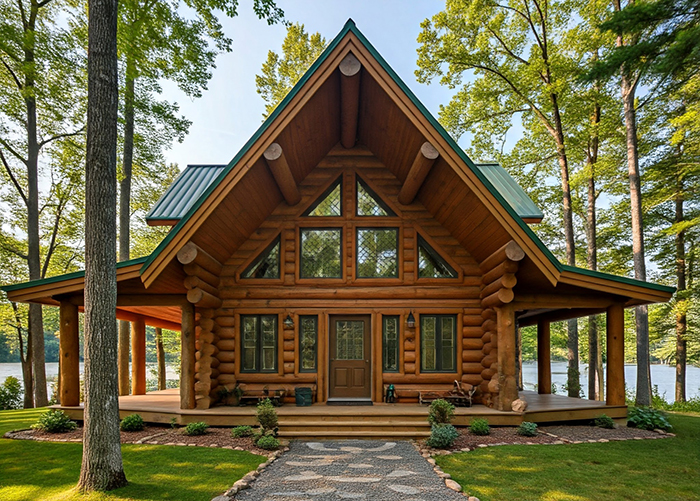How to sell your second home
There are lots of reasons for selling a second home. You may be looking for a change, going through a separation, or noticing the property value has gone up. In some regions, the price of cottages and condos has doubled , which is advantageous for sellers.

Since the pandemic, the secondary residence sector has been quiet due to rising interest rates. However, this trend seems to be reversing, as the key rate has been dropping since the summer of 2024. This is encouraging news for the cottage market, which is particularly important for the Laurentides and other regions of Quebec.
Understanding tax implications is crucial when selling your cottage, condo or any other secondary residence, especially since June 25, 2024, when the motion concerning the new capital gains tax inclusion rate was tabled. Previously, 50% of the capital gain was taxable, but now the rate is 66.7% for gains exceeding $250,000.
|
Tips and tricks Please note that the new regulations introduced last June have not yet been officially enshrined in law as of January 2025. However, government authorities suggest that you calculate your tax rate according to the new regulations. Contact your financial advisor to learn about the full tax implications of selling a second home, and to make sure you fill out your tax return properly. |
What’s the difference between a secondary and principal residence?
A principal residence is where you live most of the time. It’s different from a second home (e.g., a lakeside cottage, a cabin in the mountains, an apartment for working in the city or a slopeside condo), which is only occupied for part of the year, such as on weekends or during holidays.
Principal residence
As a Canadian taxpayer, you must declare your principal residence on your income tax return. If you designate a property as your principal residence, you may be exempt from capital gains tax on the sale, depending on the circumstances.
The residence must meet the following conditions to be considered a principal residence by the Government of Canada:
- It’s a housing unit, a leasehold interest in a housing unit, or a share of the capital stock of a co-operative housing corporation.
- You own the property.
- You, your current or former spouse or common-law partner, or any of your children lived in it at some time during the year.
- You designate the property as your principal residence.
Remember that you can only designate one property as your principal residence per year, whether you’re an owner or a tenant. However, there may be some exceptions and complexities. Professionals such as accountants, tax specialists, real estate brokers and financial planners can help you figure out the details for your situation.
Secondary vs. seasonal residence
Is your cottage a secondary or seasonal residence? First of all, it’s not a question of where it is or how it’s built, but rather how it’s being used. The law varies slightly when classifying a residence as secondary or seasonal, depending on which province you live in.
A secondary residence is occupied regularly throughout the year, especially weekends and holidays, while a seasonal residence is occupied irregularly, occasionally, or only for certain months (e.g., a three-season cottage). However, there’s no difference when you’re selling.
What about a secondary residence you don’t live in, such as a rental property or rental home? Rental properties are real estate assets, not second homes, so they are considered investments and therefore a source of income.
Before you sell, learn the tax implications of selling a second home
So you’ve decided to sell your second home. That’s great, but before you put up the For Sale sign and share the good news with your friends, you need to calculate the taxes and learn the tax implications of selling a second home.
Learn about capital gains, the tax rate and possible exemptions
A capital gain is the amount you receive once you sell your cottage or any other residence.
Capital gain = selling price – purchase price and certain expenses |
The tax rate on capital gains is higher when you’re selling a secondary residence than when you’re selling a principal residence.
There are a few ways to reduce the tax payable on capital gains when you sell:
- Deduct renovations from the purchase price when calculating the purchase price (keep your invoices!)
- Subtract expenses related to the sale, such as the real estate broker’s commission
- Maximize your RRSPs, especially if you have unused contribution room
Example of a tax calculation for the capital gain when selling a second home
Judith bought a cottage for $125,000 before the pandemic. Over time, she did renovations ($50,000) and the property value grew.
Judith can now sell her cottage for $300,000.
Capital gains are calculated as follows: $300,000 selling price - $175,000 purchase price & renovation costs = $125,000
Judith made a capital gain of $125,000; 50% is considered a taxable gain, while the other 50% is not.
In June 2024, the tax rate for capital gains changed.
Taking this information into account, let’s say that Judith made major renovations to her cottage and made a capital gain of more than $250,000. The tax rate on the first $250,000 will be 50%. The tax rate on the rest will be 66.7%.
To help you understand the different tax rates, the table below compares the capital gains taxes for a principal residence and a second home.
|
|
||
|
Principal residence |
||
|
Scenario |
Tax payable |
|
|
If it has been the principal residence since you bought it |
No tax payable on the gain |
|
|
If the property alternates between being used as a principal residence and a secondary residence |
Tax payable on a portion of the gain |
|
|
Second home |
||
|
Scenario |
Tax payable |
|
|
If there is a gain of less than $250,000 |
50% of the gain is taxable |
|
|
If there is a gain of $250,000 or more |
|
|
Tax implications of a second home that you rent out
When your kids were young, you went to the cottage every weekend and made incredible memories. Now that they’re working, you don’t go as often. No problem—that’s no reason to leave the property unoccupied! Rent it out, but be aware that there will be tax implications.
When you change a property’s purpose, for example if you decide to rent out your cottage, you’re changing its use, so it’ll be considered a source of income or an income property.
Note: When you sell, you’ll have to pay capital gains tax (see the table above in the second home section) regardless of whether you rent out your secondary residence.
Since you now rent out your residence and have additional income, you’ll also have to pay tax on your new income (rental income minus expenses), just like any landlord. The tax rate is based on your total annual income (salary, business income, investment and rental income).
A portion of certain general costs may be considered expenses:
- Municipal taxes
- Insurance
- Utilities
- Mortgage interest
Costs directly related to renting the property out can be entirely considered expenses:
- Advertising
- Website and other marketing costs
- Property management fees
- Cleaning costs related to renting the property
Before making the decision to rent out your second home, consult your tax specialist or accountant to learn about all the tax implications and requirements.
If you’re looking to make your cottage or second home profitable, check out these 9 tips for renting your cottage hassle-free.

Key steps to selling a second home
When it’s time to sell your second home, it’s important to choose a real estate broker who knows the area well. Knowing the area means your broker can assess the property value based on the market and similar properties that have recently been sold there.
Next, it’s time to prepare the home, which can range from tidying up to major decluttering, from changing some old lights to repainting rooms. This is also a great time to do any minor repairs and renovations, as they will increase the value of your property in the long run.
Once your property is listed on Centris.ca, be sure to share it on your social media. Maybe someone you know will be interested!
Check out our complete guide to selling a property to learn the essential steps.
Documents to prepare when selling a second property
The documents you’ll need when selling your second residence are more or less the same as for any other property.
- Certificate of location
- Declarations by the seller (renovation contracts and invoices, electricity bills)
- Collateral transfer
- Inspection reports
- Purchase agreement
- Tax bills
- Notarial deeds and documents related to the building
- Declaration of co-ownership (if applicable)
If your cottage isn’t connected to a sewer network or water supply, you’ll also need to provide water quality test results for the well, as well as a septic tank layout plan that’s been approved by your municipality. Make sure to include your invoices for septic tank maintenance.
|
Tips and tricks If your second home is several hours away, try scheduling visits from multiple prequalified potential buyers on the same day. Everybody saves time! |
The costs of selling a second home
In addition to the tax implications, there are costs associated with selling a second home. For most people, the costs are the same as for selling any other house, including notary fees and the real estate broker’s remuneration.
If your second home is far from a major city, it probably needs an artesian well, in addition to a septic system. However, wells and septic systems both require testing, so you can get that done before you even put your property up for sale.
For the home inspection and the different analyses, ask your real estate broker if it’s a better idea to do these additional tests in advance and cover the costs. This strategy could help everyone avoid delays and last-minute negotiations.
|
Tips and tricks Make sure you have the maintenance and inspection invoices for your septic system as proof that you’ve kept it in good condition. |
Be careful about flipping homes
Flipping a house for an investment has been in vogue for many years. But be careful! It’s not as easy as you may think. Buying a house that could be considered a second home and selling it at a higher price in a relatively short time frame (flipping) is a fairly complex real estate transaction. Flipping a house is especially complex now because of the anti-flip tax, under which capital gains are taxable at 100%. You must have owned the property for more than 12 months at the time of sale for it to be exempt from this tax.
Understanding the ins and outs of selling a second home is essential for success
Even if selling your cottage is just an idea for now, you can maximize the sales potential of your second home with excellent advice from a real estate broker.
Frequently asked questions (FAQ)
1. What is a change in use of a property?
When the use of a property changes (for example if you lived in your house all year and decide to move into your cottage so you can rent out the house), it is called a change in use. The house you previously occupied is now considered a source of income.
2. How do I avoid paying tax when selling a second home?
There’s a tax exemption for principal residences. If you have designated your second home as your principal residence and you, your spouse or one of your children lived in it, even for a short period of time, you may be exempt from paying capital gains tax on the sale. Of course, we recommend consulting a professional (tax, accountant, real estate broker) for more information.
3. How long do you have to occupy a principal residence before selling it?
In Canada, there’s no fixed or minimum period you have to live in a residence before selling it. However, certain parameters need to be met before you can benefit from capital gains and tax exemptions.
You may have heard about the 12-month rule, which relates to flipping homes and the anti-flip tax. When you sell, you must have owned the property for a minimum of 12 months so that your profit isn’t taxed at 100%.

| The information provided in this article is for informational purposes only and does not constitute financial, legal, professional or other advice or opinions. As such, we make no warranties, express or implied, as to the accuracy, reliability, integrity or exhaustiveness of this information, which you use at your own risk. In no event shall Centris be held liable for actions made on the basis of the information contained in this article or for any damage or loss, direct or indirect, that may result from, or in connection with, the use thereof. We recommended consulting with industry professionals for personalized advice before making any decisions. |
See also:
The complete 12-step guide to selling your home
Selling your house and porting a mortgage: how to do it?
Documents to prepare when selling your home
 The Largest Number of Homes for Sale
The Largest Number of Homes for Sale



